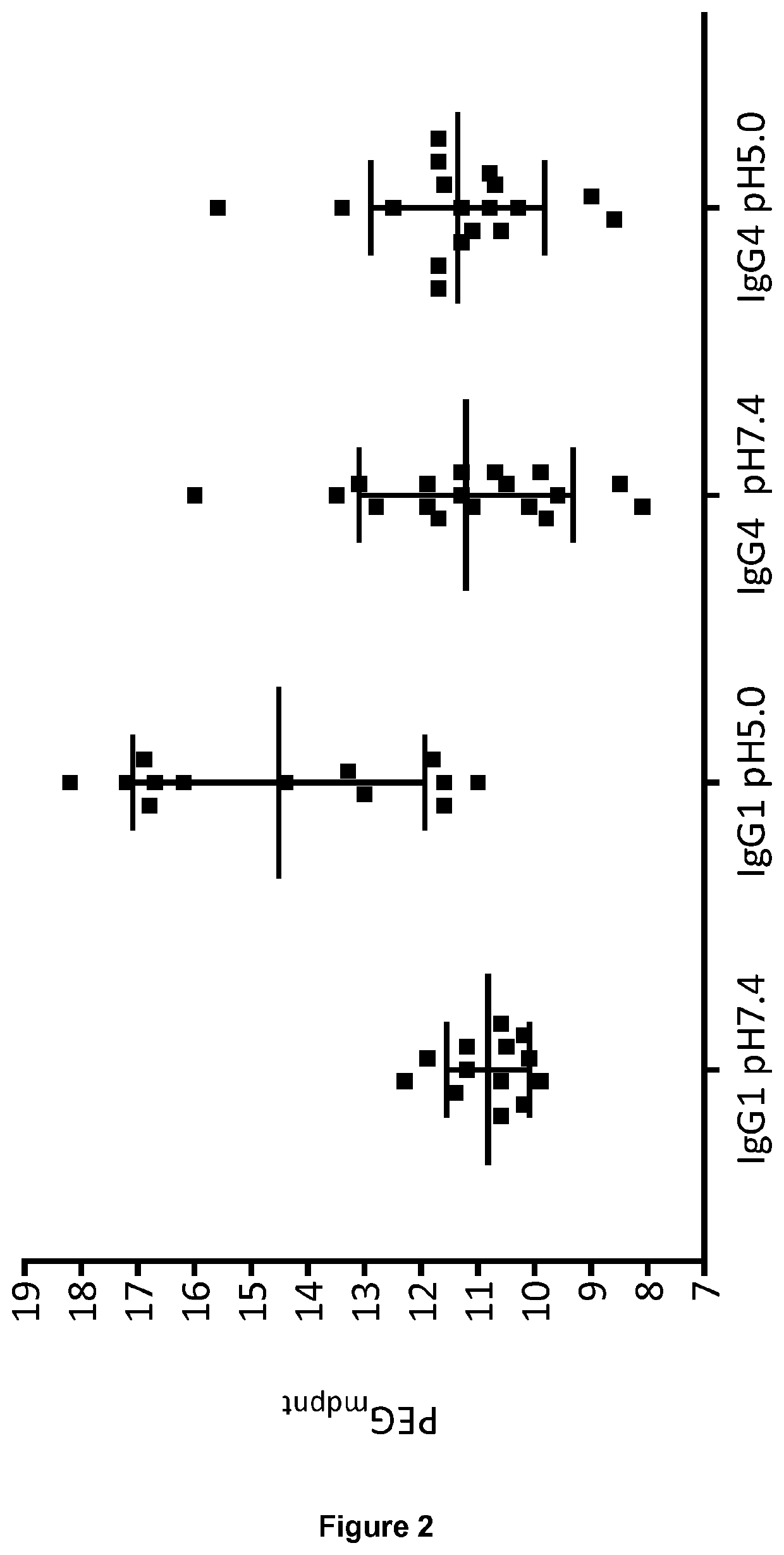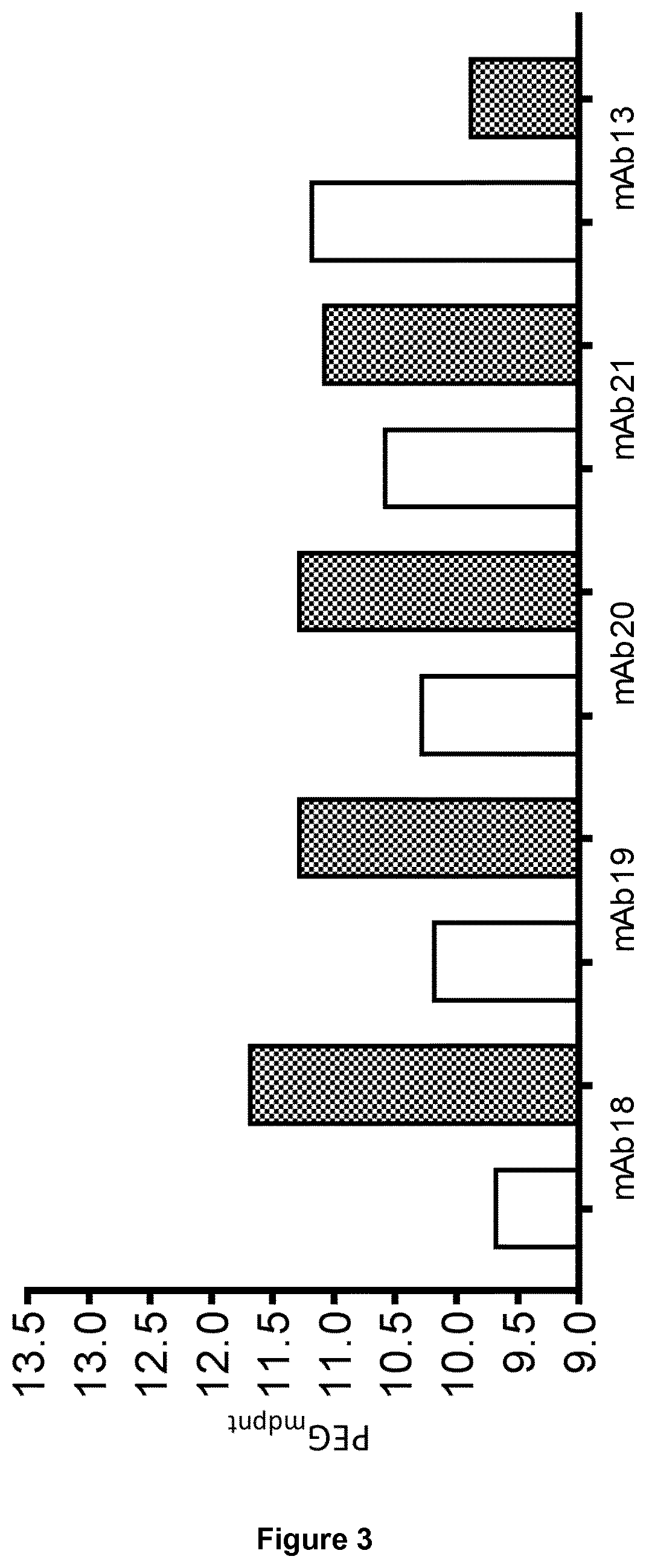Multi-domain proteins with increased native state colloidal stability
- Summary
- Abstract
- Description
- Claims
- Application Information
AI Technical Summary
Benefits of technology
Problems solved by technology
Method used
Image
Examples
example 1
Native State Colloidal Stability Measurement (PEG Aggregation Assay)
[0182]PEG-induced precipitation of the mAbs at 1 mg / mL was investigated in the presence of 7-20% PEG-3350 in PBS at pH 7.4 and 50 mM sodium acetate 125 mM sodium chloride pH 5.0. To minimize non-equilibrium precipitation, sample preparation consisted of mixing 2× protein and 2× PEG solutions at a 1:1 volume ratio in a 96 well v bottom plate. After mixing, samples were pre-incubated at 37° C. for 0.5 h to re-dissolve non-equilibrium aggregates. Samples were then incubated at room temperature for 24 h to reach equilibrium. The samples were subsequently centrifuged at 4000 g for 1 h at 20° C. Aliquots of the supernatants were immediately removed. A280 nm readings of the supernatant were taken using a FLUOstar Omega Multi-detection Microplate Reader (BMG LABTECH). Data points were plotted using Graphpad prism, PEG midpoints (PEGmdpnt) were derived from sigmoidal dose-response (variable slope) fitting protocol.
example 2
Mutant Generation
[0183]Mutations to the Fc fragment were introduced by site directed mutagenesis. Oligo's were designed to incorporate the desired mutations and ordered from Sigma. PCR reactions were set up to substitute amino acids using the Agilent Quikchange Lightning mutagenesis kits (Catalog #210518). Constructs were verified by sanger sequencing.
Transient Expression.
[0184]Heavy Chain and Light Chain plasmids were transfected into our in-house CHOSXE cell line using the ExpiCHO transfection system from Life technologies (Catalog Number A29133) ratio at a ratio of 1:2. Briefly, 100 ug DNA (total) were diluted in 4 ml Gibco OptiPRO Serum Free Media (SFM) (Thermofisher Catalog number: 12309019) and 320 ul Gibco ExpiFectamine CHO reagent (Catalog number A29129) was diluted in 4 ml OptiPRO SFM. The diluted DNA and transfection reagent was mixed and added to 100 ml cells seeded at 6×106 cells / ml. Cells were incubated on a shaking platform overnight at 37° C. On day 1 post transfectio...
example 3
Calculation of pI
Calculation of pKa
[0186]There are three methods that can be used in the pKa calculations. The first method assumes that all Cysteines are forming Cystines. If there is an uneven number of cysteines in the sequence, a single Cysteine is assumed to be free. The second method assumes that half of the Cysteines present are participating in disulphide linkages (to form Cystine). The third method assumes that none of the Cysteines are participating in disulphide bonds.
[0187]The pKa values of different amino acids used for the calculations are shown in the table below
TABLE 5pKa values of amino acids.Amino Acid ResiduepKaN-terminus9.69Lysine10.5Arginine12.4Histidine6.0C-terminus2.34Aspartate3.86Glutamate4.25(Free) Cysteine8.33Tyrosine10.0
Calculation of pI
[0188]In order to calculate the pI, a net charge vs. pH plot is generated. The following steps are performed in order to create such plot.
[0189]Step 1: for each pH (from 1.0 to 14.0 in increments of 0.1), partial charge for...
PUM
| Property | Measurement | Unit |
|---|---|---|
| Temperature | aaaaa | aaaaa |
| Temperature | aaaaa | aaaaa |
| Temperature | aaaaa | aaaaa |
Abstract
Description
Claims
Application Information
 Login to View More
Login to View More - Generate Ideas
- Intellectual Property
- Life Sciences
- Materials
- Tech Scout
- Unparalleled Data Quality
- Higher Quality Content
- 60% Fewer Hallucinations
Browse by: Latest US Patents, China's latest patents, Technical Efficacy Thesaurus, Application Domain, Technology Topic, Popular Technical Reports.
© 2025 PatSnap. All rights reserved.Legal|Privacy policy|Modern Slavery Act Transparency Statement|Sitemap|About US| Contact US: help@patsnap.com



